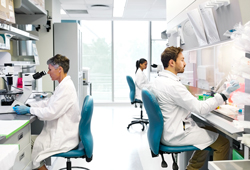“March-In” Rights in the Era of COVID-19: An Unlikely Scenario for Remdesivir

As the total number of COVID-19 deaths in the U.S. is expected to climb to between 180,000 to 200,000 by September 5, 2020[1][2], there currently are no FDA-approved vaccines or drugs to prevent or treat COVID-19. However, the FDA has granted emergency use authorizations to some products for use in certain patients with COVID-19, including to Gilead for its investigational antiviral drug remdesivir[3].
On August 4, 2020, a bipartisan group of 34 state attorneys general (AGs) asked the U.S. government to exercise its march-in rights under the Bayh-Dole Act and license Gilead’s remdesivir to third-party manufacturers in order to scale up production and lower the price of the drug, or allow states to do so.[4] The AGs argued that the U.S. government should exercise its march-in-rights because the price of remdesivir is too high and because Gilead “has benefited from millions of dollars of public funding, including a $30-million NIH-funded clinical trial,” and “is unable to assure a supply of remdesivir sufficient to alleviate the health and safety needs of the country.”[5]
The AGs’ request that the U.S. government exercise its march-in rights under the Bayh-Dole Act, however, does not appear to be tethered to the law.
Under the Bayh-Dole Act, in specific circumstances, the U.S. government has the right to “march-in” and either grant licenses, or require the patent holder/licensee to grant licenses, to third parties under federally funded patents.[6] The U.S. government may exercise its march-in rights if it determines that action is necessary because the patent holder or licensee:
- has not taken, or is not expected to take within a reasonable time, effective steps to achieve practical application of the subject invention;
- is not reasonably satisfying health or safety needs;
- is not reasonably satisfying regulatory requirements for public use; or
- has violated the U.S. industry preference provisions of 35 U.S.C § 204.[7]
If the U.S. government decides to exercise its march-in rights, the decision may be appealed to the U.S. Court of Federal Claims, and with respect to items (1) and (3) above, march-in rights may not be exercised until all appeals or petitions are exhausted.[8]
Despite having the authority, the U.S. government has never exercised its march-in rights. In its response to a 1997 petition requesting that the NIH exercise it march-in rights, the NIH noted its unwillingness “to influence the marketplace for the benefit of a single company, particularly when such actions may have far-reaching repercussions on many companies’ and investors’ future willingness to invest in federally funded medical technologies,”[9] and, with respect to drug pricing, in response to a 2004 petition, the NIH noted that “because the market dynamics for all products developed pursuant to licensing rights under the Bayh-Dole Act could be altered if prices on such products were directed in any way by NIH, the NIH agrees with the public testimony that suggested that the extraordinary remedy of march-in is not an appropriate means of controlling prices.”[10]
Given the fact that: (a) march-in rights are limited to federally funded patented inventions (and it is not clear to what extent federal funds contributed to the development or remdesivir[11]), (b) the Bayh-Dole Act is not triggered by high drug prices, (c) the NIH’s unwillingness to exercise its march-in rights, particularly because it does not want to disincentivize innovation and does not believe that the Bayh-Dole Act should be used to control drug prices, and (d) the patent holder/licensee has the ability to appeal the U.S. government’s decision to exercise its march-in rights, and some instances march-in rights may not be exercised until all appeals or petitions are exhausted, it seems unlikely that the Bayh-Dole Act will be invoked in response to the AGs’ request that the U.S. government exercise its march-in rights.
_______________________________________________________________________________________
[1] According to the Centers for Disease Control and Prevention (CDC) COVID Data Tracker, as of August 21, COVID-19 has claimed 173,490 lives. https://www.cdc.gov/covid-data-tracker/#cases
[2] https://www.cdc.gov/coronavirus/2019-ncov/covid-data/forecasting-us.html#anchor_1587397564229
[3] https://www.gilead.com/purpose/advancing-global-health/covid-19
[4] https://www.oag.ca.gov/system/files/attachments/press-docs/Remdesivir%20Letter%2020200804.pdf
[5] https://www.oag.ca.gov/system/files/attachments/press-docs/Remdesivir%20Letter%2020200804.pdf
[6] 35 U.S.C. §203(a).
[7] 35 U.S.C. §203(a).
[8] 35 U.S.C. §203(b).
[9] Harold Varmus, Director, NIH, Determination in the Case of Petition of CellPro,Inc., August 1, 1997,
[10] Elias A. Zerhouni, Director, NIH, In the Case of Norvir Manufactured by Abbott Laboratories, Inc., July 29, 2004,
http://www.ott.nih.gov/sites/default/files/documents/policy/March-In-Norvir.pdf.
[11] https://www.statnews.com/pharmalot/2020/05/08/gilead-remdesivir-covid19-coronavirus-patents/



 As the COVID-19 pandemic unfolds, our drug, biologic, and medical device clients conducting or planning to conduct clinical trials may be faced with challenges related to quarantines, travel limitations, site closures or access restrictions, infection transmission concerns of site research personnel and study subjects, and supply chain interruptions. Nonetheless, it remains critical during the COVID-19 pandemic to continue to assure the safety of trial participants, comply with good clinical practice (GCP) requirements, and minimize risks to trial integrity. In this client alert which follows our earlier article on product development considerations for COVID-19 and article on FDA scrutiny of COVID-19 medical product marketing, we briefly discuss the impact the COVID-19 pandemic may have on our life sciences clients, and we provide an overview of FDA’s “Guidance on Conduct of Clinical Trials of Medical Products during COVID-19 Pandemic” issued on March 18, 2020.
As the COVID-19 pandemic unfolds, our drug, biologic, and medical device clients conducting or planning to conduct clinical trials may be faced with challenges related to quarantines, travel limitations, site closures or access restrictions, infection transmission concerns of site research personnel and study subjects, and supply chain interruptions. Nonetheless, it remains critical during the COVID-19 pandemic to continue to assure the safety of trial participants, comply with good clinical practice (GCP) requirements, and minimize risks to trial integrity. In this client alert which follows our earlier article on product development considerations for COVID-19 and article on FDA scrutiny of COVID-19 medical product marketing, we briefly discuss the impact the COVID-19 pandemic may have on our life sciences clients, and we provide an overview of FDA’s “Guidance on Conduct of Clinical Trials of Medical Products during COVID-19 Pandemic” issued on March 18, 2020. Because life sciences companies hope to never end up on clinical hold, preparing for such a call from the U.S. Food and Drug Administration (FDA) is often not on the to-do list. But there can be significant advantages to advance preparation. Our Goodwin Insight shares some tips for life sciences companies on navigating that first call with FDA and the actions that follow.
Because life sciences companies hope to never end up on clinical hold, preparing for such a call from the U.S. Food and Drug Administration (FDA) is often not on the to-do list. But there can be significant advantages to advance preparation. Our Goodwin Insight shares some tips for life sciences companies on navigating that first call with FDA and the actions that follow. What financial arrangements between clinical trial sponsors and clinical investigators must be disclosed in a drug, biologic or device marketing application?
What financial arrangements between clinical trial sponsors and clinical investigators must be disclosed in a drug, biologic or device marketing application?